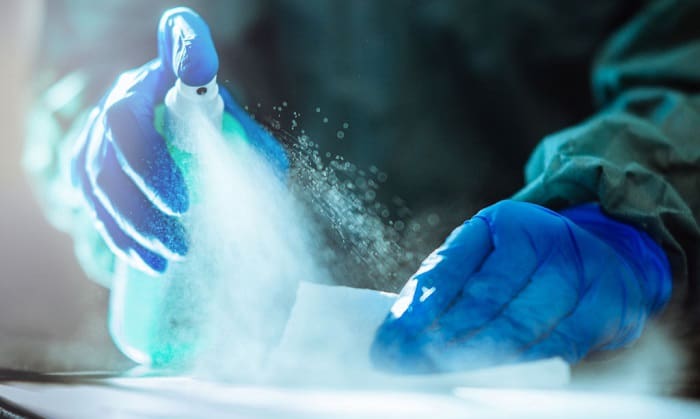Chemicals are among the hazards that are present in many workplaces. They vary due to different destructive levels that gradually harm our skin or burn it red right away. That’s why we require protective gloves that shield against hazardous liquids.
So, what are chemical-resistant gloves? In short, chemical-resistant gloves are formulated and tested to prevent direct exposure to dangerous agents and surfaces. Their level of protection depends on the materials used and the manufacturing process. Therefore, to know if a pair works for you, check out our detailed information below.
Table of Contents
What Are Chemical Resistant Gloves Made of?
When looking for chemical safety gloves, you can notice they are made of different plastic and rubber types. The standard pairs produced for workers to protect against hazards in various tasks include:
1. Latex rubber gloves
These products are often used for general-purpose tasks. This material comes with excellent tensile strength to endure stretching and abrasion. Also, these gloves can withstand high temperatures while offering good elasticity for our hand movements.
These gloves keep our skin safe from water solutions of alkalis, salts, acids, and ketones.
2. Nitrile gloves
Nitrile is another material often used in manufacturing chemical protective gloves. Nitrile gloves are formulated from a copolymer, providing reliable protection against chlorinated solvents.
In other words, workers should wear this pair when dealing with perchloroethylene and trichloroethylene. They can be found in paint removers, water repellents, adhesives, sealants, lubricants, cleaning products, etc.
Furthermore, these gloves can shield against acids, just like latex rubber gloves. But they can also deal with grease, caustics, oils, and alcohols, making these pairs versatile.
3. Butyl gloves
For workers that handle more potent and highly corrosive chemicals, butyl gloves are the trustworthy option. They prevent us from being exposed to the hazardous effects of rocket fuels, acids, peroxides, and strong bases.
Another perk of these thick and functional gloves is the incredible flexibility in cold temperatures. They can resist abrasion and oxidation, too.
4. Neoprene gloves
As chemical-resistant gloves, these products benefit workers who value high flexibility. For people who need to handle work with details, these gloves with excellent pliability allow finger dexterity. Of course, they are also durable with high-density material that resists wear and tear.
When wearing these gloves, we are guaranteed protection against hydraulic fluids, alcohols, alkalis, gasoline, and organic acids. These gloves are indeed more rugged than natural or latex rubber gloves in defending against chemicals and wear and tear.
What Are They Used for?
As stated above, chemical-resistant gloves protect against various kinds of substances with different danger levels.
According to the Occupational Safety and Health Administration (OSHA), we must wear chemical-resistant gloves for fending ourselves against cuts, abrasions, burns, extreme heat, and chemicals or other harmful substances.
That means chemical-resistant gloves are not formulated with a single purpose but incorporate multiple safety features. You should know that there are levels to those protection functions to cater to your work, so make sure to see their grade before purchase.
How Can We Choose Chemical-resistant Gloves?
OSHA suggests that when you find a good pair to resist chemicals at work, pay attention to these factors:
- The chemical types you deal with every day
After checking this factor, which should involve figuring out the formulas of substances you come into contact with, make sure to find the right glove materials that can handle them.
- Immersion or splash contact with those chemicals
When dealing with immersion or splash of a toxic solution, you should go for long gloves, at least over 14 inches.
- The contact/exposure duration
Permeation rate is what you should notice on the glove description. It determines how fast the chemical can pass through the glove. Pairs with a rate of excellent (E) are ideal for submerging in hazardous solutions for the longest time. Then, G is for good, F is fair, and P is poor.
- The length and thickness of the gloves
Depending on the nature of contact with the dangerous substance, you can choose the right length and thick gauge for your duties. Just note that thicker pairs resist chemicals and other hazards like cuts and punctures better.
- Flexibility and finger dexterity
As a matter of fact, thinner gloves allow better dexterity, which is essential for intricate tasks. Yet, these pairs might not protect your hands that well against chemicals.
- Comfort
The glove’s linings and finishes vary, depending on the level of grip it intends to offer. The most common are the cotton flock and knit liners, ideal for absorbing moisture for comfort.
Are Nitrile Gloves Chemical Resistant?
Yes. Nitrile is among the materials used for making gloves for handling chemicals. In fact, nitrile gloves are both chemical and abrasion-resistant, ensuring good shielding for general duties. In detail, it offers short-term protection against oils, fuels, weak acids, weak caustics, and some organic solvents.
Conclusion
I hope we have made all the points clear when discussing ‘What are chemical-resistant gloves?’ and highlighting the importance of this personal protective equipment (PPE).
Of course, we can not go to work and neglect our safety by not gearing ourselves with sufficient gloves. And we can achieve that by selecting the right pair that meets our job’s requirements.
If you find the article helpful, do not hesitate to leave a comment or share it with your colleagues. Thank you for reading.

This is Edward Manning, the editor in chief of Construction Informer. Quite a bit of my time is spent researching the market and interviewing experts in the field so that I can give you reliable information.




